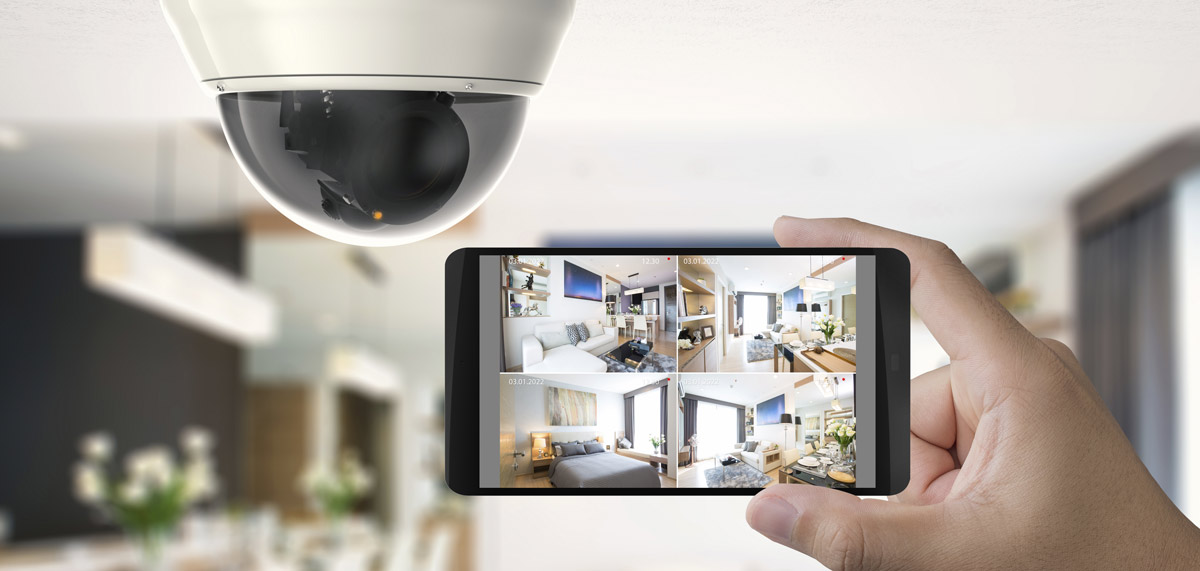Published: 06/21/2019
Today’s security cameras are built with smart and proactive features to make home surveillance easy and stress-free. Due to these advances in technology, installing a home security system is now easier and cost-effective than ever before. As a result, 17% of homes in the United States have a home security system in place. And by 2020, a report by NextMarket Insights projects the number of people using smart security is expected to rise to over 22 million.
If you don’t fall within the 17% of homeowners with an existing security system, we’ve created this beginners guide to security cameras to help you select the best cameras for you and your home.
Types of Security Cameras
fixed cameras
A fixed security camera is the simplest most basic camera available. While a basic camera may seem less advantageous, it does have its list of benefits. For one, unlike 360º and PTZ cameras, a fixed camera has few moving parts and therefore less that can go wrong. Additionally, since the direction of the camera isn’t adjustable, it will remain pointing in the desired direction.
360º Cameras
360º cameras consist of multiple cameras placed in a single housing unit (typically a dome camera) where the images produced are stitched together. However, because there are cameras in every direction, without an unobstructed view, 360º cameras don't provide the desired benefits and often times it is difficult to find an ideal location to place the camera.
PTZ (Pan/tilt/zoom) Cameras
PTZ or pan/tilt/zoom cameras get their name from the vast array movement options of the camera. PTZ cameras can quickly and easily, remotely adjust, providing you with a detailed view of what’s happening inside and outside your home.
One of the main benefits of a PTZ camera is that they make it possible to monitor a large space with fewer cameras. A single PTZ camera can replace multiple traditional security cameras. Making them great for commercial applications such as use airports, office buildings, shopping malls, and apartment buildings.
Security Camera Housing Types
Dome cameras
As their name suggests, dome cameras have a dome-shaped housing and are widely used both inside and outside homes and commercial buildings.
The main advantage of using a dome camera is that it is often difficult to determine which way the camera is facing (some cameras do a better job at this than others). Dome cameras are more durable and resistant to vandalism than other security camera housing types.
Amcrest UltraHD Outdoor 4-Megapixel PoE Vandal Dome IP Security Camera - MicroSD Storage, IP67 Weatherproof, IK10 Vandal-Proof, 4MP (2688 TVL), IP4M-1028E (White)
bullet cameras
In contrast to a dome camera, bullet cameras are shaped more like a rifle. Bullet cameras are often placed outside of a home or building pointing in a single direction. Unlike a dome camera, the direction and orientation of the camera is very obvious.
Three of the main advantages to using a bullet camera over a dome camera are because bullet cameras are more versatile in placement, they are easier to keep clean, and tend to produce a clearer image due to their ability reflect light (some cameras do this better than others).
Amcrest UltraHD 4K (8MP) Outdoor Bullet POE IP Camera, 3840x2160, 131ft NightVision, 2.8mm Lens, IP67 Weatherproof, MicroSD Recording, Black (IP8M-2496EB)
discreet Cameras
Discreet cameras, unlike dome and bullet cameras, are more concealed and hidden with the objective of not being seen. These types of cameras are more commonly placed within a home and may also be referred to as spy cameras or nanny cameras. Discreet cameras can be hidden in a variety of everyday household items such as teddy bears, phone charging blocks, smoke alarms and more.
Security Camera Features
Resolution
Camera resolution and definition is typically the most important feature for those looking to purchase a new security camera. And as you can imagine, the image resolution options are better than ever. You can find cameras on the market with up to 4k resolution.
There are a few downsides to a higher-resolution camera. One of these being, the higher the resolution, the more space is required to store and manipulate the images produced. Luckily, it generally isn’t that expensive to increase storage availability regardless of where you plan on storing these images. The other potential negative to a higher resolution is that higher resolution cameras typically don’t respond as well to low-light situations as a lower resolution camera. So it is possible to purchase a camera with more resolution than you need, increasing storage costs and decreasing performance.
Night vision
Clear night vision is one of the most important features of an outdoor security camera. Selecting a camera with infrared (IR) technology will produce the best and brightest image in low light. For the best visibility, we recommend you choose a camera with night visibility of up to 100-feet or more.
mobile remote control
Depending on how you plan on monitoring your cameras, a mobile app can provide you with a live feed directly on your mobile device.
In general, there are two types of surveillance view apps on the market, proprietary apps, and third-party apps. A proprietary app will only work with the companies own IP security cameras at no extra cost. Third-party apps are compatible with different brands of cameras and very likely will cost you a monthly fee to use. If you plan on utilizing a third-party app, make sure it is compatible with the cameras you plan on purchasing.
PoE (Power Over Ethernet)
The most modern connection type uses a single Ethernet cable to receive power and transmit video. These type of connection can handle video resolutions of 4K+ surpassing the limits of older BNC HD-TV cameras. PoE cameras can allow for more flexible placement options, as they don’t rely on power outlets or wireless signal range limits.
Tamper Detection
Using a camera with tamper detection capabilities will allow you to receive an email or SMS notification whenever the camera is vandalized or physically attacked, the view becomes obscured, or if the power line is cut to the camera.
Security Camera FAQ’s
Q: Do security cameras record all of the time?
A: Security cameras can be set to record continuously, based on a schedule, or when motion is detected. This can easily be adjusted within the camera’s settings.
Keep in mind, if your cameras are set to record continuously, they will take up more storage space and therefore will allow for shorter historical recordings. If the cameras are battery-powered it would greatly shorten the battery life to be in continuous recording mode.
Q: Where is the best place to put an outdoor security camera?
A: We commonly place security cameras in the corners of your home under the soffit. This creates better viewing angles and tamper prevention.
Q: Is there a security camera that works without WiFi?
A: Yes, the majority of professional or high-end cameras still rely on wires.
Q: What internet speed do you need for security cameras?
A: To view them online, at least 10Mb/s.
Q: Are WiFi security cameras reliable?
A: WiFi cameras are reliable, though less so than wired cameras. They also typically have poorer picture quality for the same cost. This is due to potential interference from radio interference, your home’s walls or the distance from the WiFi.
Q: Do you need WiFi for wireless security cameras?
A: Some security cameras use your home’s WiFi while others create their WiFi from a DVR. Cameras that include their own DVR will communicate directly with the DVR rather than your home's network.
Q: Do WiFi cameras use data?
A: Yes, if you view your cameras without being connected to the same network, you will use your home’s internet data and your phones data.
Q: How far can you run IP cameras?
A: There isn’t an exact maximum distance for an IP camera run. The number varies depending on the network speed. As a general rule of thumb, with a cat5 or cat6 cable, 328-foot (100 meters) limit. If necessary, there are ways to extend this limit. The most common way of doing so is by installing additional network switches before the 100-meter limit. Another option is to use an Ethernet Extender. These are useful in situations where adding a switch isn’t possible.
How perk-it Can Help
If you are still having a difficult time selecting the best camera type with the appropriate housing and features, feel free to give us a call at (801) 910-9838 or if you prefer, by completing our contact form. Our expertise and years of experience can you get started on the right track. And if you happen to be located in Salt Lake City, Utah, we can schedule a no-obligation consultation to provide you with any recommendations.
Related Posts
burglary Statistics
Each year there are 2.2 million burglaries in the United States, meaning one burglary occurs every fifteen seconds.
On average, the monetary loss from a burglary in the United States is $2,000, with the common stolen items including stolen cash, jewelry, guns, drugs, and small electronics.
Break-ins are 6% more likely to occur during the day between 6am and 6pm while people are at work or running errands.
Homes without a security system in place are 300% more likely to be burglarized.
Burglary rates increase an average of 11% over the summer months as a result of warmer temperatures. In some cities the increase can be as high as 35%.





















